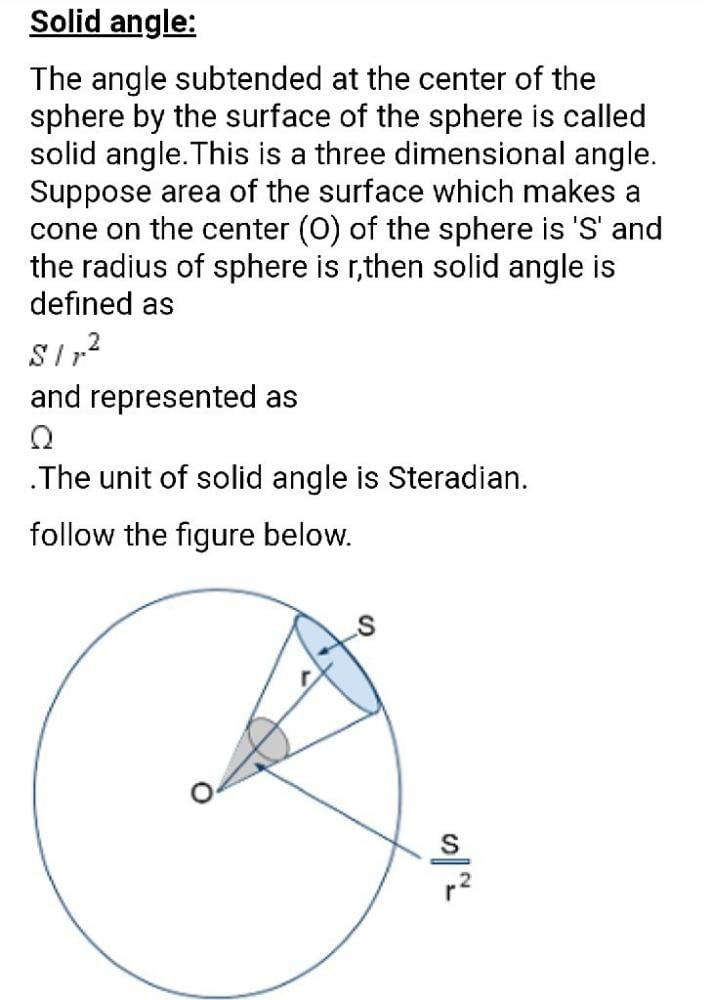Class 12 Exam > Class 12 Questions > Solid angle subtented at the centre of sphere...
Start Learning for Free
Solid angle subtented at the centre of sphere by its whole surface?
Most Upvoted Answer
Solid angle subtented at the centre of sphere by its whole surface?
Introduction
The solid angle subtended at the centre of a sphere by its whole surface is an important concept in geometry. In this concept, we consider a sphere and we want to find out the solid angle that it subtends at its centre. This is an important concept in many areas of physics, particularly in optics and electromagnetism.
Definition of Solid Angle
Solid angle is a measure of the amount of three-dimensional space that is enclosed by a surface. It is defined as the ratio of the surface area of a portion of a sphere to the square of its radius.
Formula for Solid Angle
The formula for solid angle is given by:
Ω = A / r²
where Ω is the solid angle in steradians, A is the surface area of the portion of the sphere and r is the radius of the sphere.
Calculation of Solid Angle
To calculate the solid angle subtended at the centre of a sphere by its whole surface, we need to consider the entire surface area of the sphere. The surface area of a sphere is given by:
A = 4πr²
where A is the surface area and r is the radius of the sphere.
Substituting the value of A in the formula for solid angle, we get:
Ω = (4πr²) / r²
Ω = 4π
Therefore, the solid angle subtended at the centre of a sphere by its whole surface is 4π steradians.
Conclusion
In conclusion, the solid angle subtended at the centre of a sphere by its whole surface is an important concept in geometry and physics. It is defined as the ratio of the surface area of a portion of a sphere to the square of its radius. The formula for solid angle is given by A / r². By calculating the entire surface area of the sphere and substituting it in the formula, we can determine that the solid angle subtended at the centre of a sphere by its whole surface is 4π steradians.
The solid angle subtended at the centre of a sphere by its whole surface is an important concept in geometry. In this concept, we consider a sphere and we want to find out the solid angle that it subtends at its centre. This is an important concept in many areas of physics, particularly in optics and electromagnetism.
Definition of Solid Angle
Solid angle is a measure of the amount of three-dimensional space that is enclosed by a surface. It is defined as the ratio of the surface area of a portion of a sphere to the square of its radius.
Formula for Solid Angle
The formula for solid angle is given by:
Ω = A / r²
where Ω is the solid angle in steradians, A is the surface area of the portion of the sphere and r is the radius of the sphere.
Calculation of Solid Angle
To calculate the solid angle subtended at the centre of a sphere by its whole surface, we need to consider the entire surface area of the sphere. The surface area of a sphere is given by:
A = 4πr²
where A is the surface area and r is the radius of the sphere.
Substituting the value of A in the formula for solid angle, we get:
Ω = (4πr²) / r²
Ω = 4π
Therefore, the solid angle subtended at the centre of a sphere by its whole surface is 4π steradians.
Conclusion
In conclusion, the solid angle subtended at the centre of a sphere by its whole surface is an important concept in geometry and physics. It is defined as the ratio of the surface area of a portion of a sphere to the square of its radius. The formula for solid angle is given by A / r². By calculating the entire surface area of the sphere and substituting it in the formula, we can determine that the solid angle subtended at the centre of a sphere by its whole surface is 4π steradians.
Community Answer
Solid angle subtented at the centre of sphere by its whole surface?


|
Explore Courses for Class 12 exam
|

|
Solid angle subtented at the centre of sphere by its whole surface?
Question Description
Solid angle subtented at the centre of sphere by its whole surface? for Class 12 2024 is part of Class 12 preparation. The Question and answers have been prepared according to the Class 12 exam syllabus. Information about Solid angle subtented at the centre of sphere by its whole surface? covers all topics & solutions for Class 12 2024 Exam. Find important definitions, questions, meanings, examples, exercises and tests below for Solid angle subtented at the centre of sphere by its whole surface?.
Solid angle subtented at the centre of sphere by its whole surface? for Class 12 2024 is part of Class 12 preparation. The Question and answers have been prepared according to the Class 12 exam syllabus. Information about Solid angle subtented at the centre of sphere by its whole surface? covers all topics & solutions for Class 12 2024 Exam. Find important definitions, questions, meanings, examples, exercises and tests below for Solid angle subtented at the centre of sphere by its whole surface?.
Solutions for Solid angle subtented at the centre of sphere by its whole surface? in English & in Hindi are available as part of our courses for Class 12.
Download more important topics, notes, lectures and mock test series for Class 12 Exam by signing up for free.
Here you can find the meaning of Solid angle subtented at the centre of sphere by its whole surface? defined & explained in the simplest way possible. Besides giving the explanation of
Solid angle subtented at the centre of sphere by its whole surface?, a detailed solution for Solid angle subtented at the centre of sphere by its whole surface? has been provided alongside types of Solid angle subtented at the centre of sphere by its whole surface? theory, EduRev gives you an
ample number of questions to practice Solid angle subtented at the centre of sphere by its whole surface? tests, examples and also practice Class 12 tests.

|
Explore Courses for Class 12 exam
|

|
Signup for Free!
Signup to see your scores go up within 7 days! Learn & Practice with 1000+ FREE Notes, Videos & Tests.

















